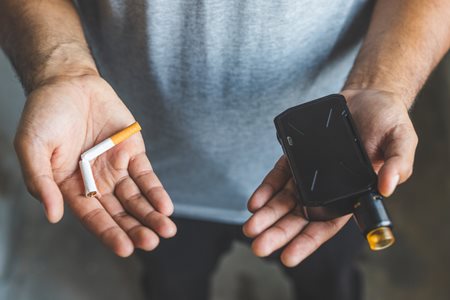Electronic cigarettes or e-cigarettes (more commonly known as vapes) first hit the market in 2007. Within seven years, they were the “most commonly used tobacco product among U.S. youth,” according to the Centers for Disease Control and Prevention.
As e-cigarettes became more accessible, more people — and especially teens — started using them.
The FDA estimated that more than 2 million U.S. middle and high school students used e-cigarettes in 2021, with more than 8 in 10 preferring flavored e-cigarettes. The stats for U.S. adults in America are similar: Six percent vape regularly and 52% vape occasionally or when they are in social settings, according to the FDA.
What’s an e-cigarette?
 E-cigarettes come in many shapes and sizes. They may look like regular cigarettes or be shaped like a cigar or pipe. But they can also look more like other objects you may not suspect are vapes — like a pen or flash drive.
E-cigarettes come in many shapes and sizes. They may look like regular cigarettes or be shaped like a cigar or pipe. But they can also look more like other objects you may not suspect are vapes — like a pen or flash drive.
Vapes usually have a battery, a place for liquid and a heating element. While many users smoke a liquid containing a flavored nicotine, vapes can be used with marijuana or other illegal drugs.
Vaping comes with severe risks
While the CDC has confirmed that vaping conveys fewer toxic chemicals than a traditional cigarette, there’s still a health risk. “You’re vaporizing a liquid that has three components,” explained Dr. Vipul Jain, medical director, chronic lung disease, UCSF Fresno. “There’s solvents … there’s flavoring … and then there’s nicotine.”
For teens, nicotine can be especially addictive. Brain development continues through childhood to about age 25. Nicotine exposure to the developing brain can cause addiction and lung damage.
There can also be risk to your heart and immune system, says Dr. Jain. “The body sees the nicotine and doesn’t care what form it was delivered,” said Dr. Jain. “Nicotine is still the same chemical and poses the same health risks.” Even the flavoring in vapes — from cotton candy to fruit and other dessert flavors — is problematic. Flavoring chemicals, such as diacetyl, a common chemical in flavored vaping systems, is directly related to severe lung disease.
Vaping won’t help you quit smoking
 While many tobacco companies claim that vaping can help you quit smoking, there is little proof that this is the case.
While many tobacco companies claim that vaping can help you quit smoking, there is little proof that this is the case.
“E-cigarettes are not currently approved by the FDA as a quit-smoking aid. The U.S. Preventive Services Task Force, a group of health experts that makes recommendations about preventive health care, has concluded that there is insufficient evidence to recommend e-cigarettes for smoking cessation in adults, including pregnant adults,” the CDC said.
While e-cigarettes may be less harmful than cigarettes, they are still addicting. When a person is dependent on (or addicted to) nicotine and stops using it, their body and brain have to get used to not having nicotine. This can result in temporary nicotine withdrawal symptoms, including irritability, restlessness, feeling anxious or depressed, trouble sleeping and problems concentrating.
3 steps to help you quit vaping
If you or someone you know needs to quit smoking or vaping, talk to your doctor. These tips may also help:
-
Surround yourself with supportive people — Many people see smoking or vaping as a social activity. If you’re trying to quit, be sure to surround yourself with a support system of people who will encourage you and help you stay on track.
-
Choose how to quit and talk to your doctor — While some users may choose to stop smoking in one day or go “cold turkey,” your doctor might advise other methods for you. Your doctor can also tell you what side effects one might expect from nicotine withdrawal, such as headaches or nausea.
-
Fill the time you would usually spend smoking with doing something else — It’s easy to fall into old habits, like having a cigarette before bed or when you’re out socializing with friends. Think about what activities you can do to fill this time instead. Going for a walk, writing in your journal or calling a friend may be what you need to distract yourself so you’re not tempted to relapse.
Resources for parents
If you fear your child or teen is using e-cigarettes, talk with them, especially if you have used tobacco yourself, or still use tobacco, says the CDC.
Of course, be clear that you don't approve of them smoking and from experience you know that they will live a healthier life if they are tobacco-free.
The CDC offers a Parent Tip Sheet with facts and practical ways to start conversations with kids about the risk of vaping and nicotine.




.jpg)


